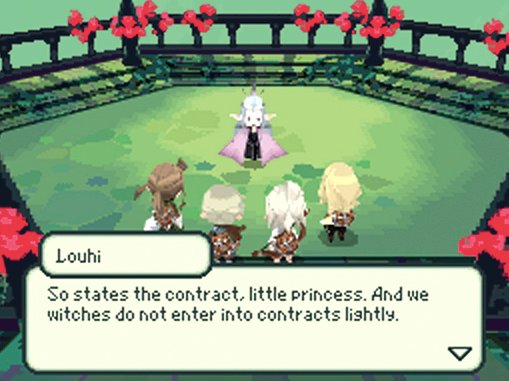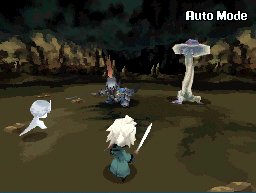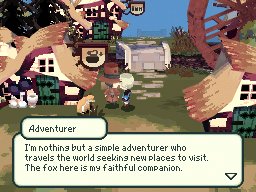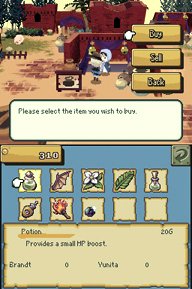In part, The 4 Heroes of Light is a nostalgic throwback to a time when the words ‘Final’ and ‘Fantasy’ weren’t shorthand for ‘aaaargghh’ and ‘stop talking’, respectively. Contrary to the lengthy, soap opera-like cutscenes that make up Final Fantasy XIII, 4 Heroes doesn’t mess about at all.

The heroes converge after a short jaunt to rescue a princess who’s been captured by the evil Witch of the North. With the witch thrashed, the princess, her female bodyguard and two boys from the neighboring village set out to save the area from a sudden curse. There are cutscenes along the way – well, static dialogue scenes, really – but they’re brief and perfunctory, clearly designed not to get in your way.
Where Dragon Quest IX made you wait ages before letting you recruit party members or change classes, here you’re

wearing a new hat and running around with friends within the hour. It’s refreshingly straightforward, but this throwback to the minimalism of the early Final Fantasys doesn’t come without a few setbacks.
Our biggest concern so far is with the lack of direction. While the increased freedom is appreciated, finding the location of the next dungeon or town seems totally dependent upon chatting with the right NPC, or even stumbling into it by chance. And actually getting there is another matter entirely. When you do acquire a map, it’s tiny, cluttered and restricted to the overworld, leaving you fumbling in the dark during dungeons. We’re hoping there’s some way to map out these confusingly structured areas later on – and, while we’re at it, mitigate the irritatingly high encounter rate – but we didn’t come across one during our time with the first four or five hours of the game.
4 Heroes seems strangely archaic in other ways too. When characters left our party, which happened without warning, they took with them every item we left on their person or that the game had randomly assigned to their inventory after a battle. Thanks for leaving us in the lurch, bub. Item-hunting, meanwhile, reverts to the bad old days of running around and pressing A on everything – there are no visual clues when you’re near a hidden object. Couple this with the stingy item limit and the bizarre decision to make you carry spellbooks everywhere in order to cast magic and you have a game so beholden to the past that it’s actually quite frustrating to play.
On the other hand, this just might be one of the purest, most immediately rewarding Final Fantasy games we’ve played. The battle system is swift, streamlined and surprisingly tactical – and it’s all thanks to the removal of Magic Points.
Weekly digests, tales from the communities you love, and more

Every action, from attacking to casting spells, consumes a certain amount of AP. One point recharges after every turn, but you can Boost to increase this to two, giving you more points and more options to play with. This changes the flow of battle considerably – with no MP to worry about, you’re free to exploit your most powerful spells, but only if you’re willing to sacrifice one of your turns first. It’s an effective and challenging system – you can’t even use healing spells outside of battle unless you’ve saved up some AP from the previous fight.
Jobs have long been a huge part of Final Fantasy, and the Crown system reduces that concept to its barest essence, letting you change jobs at the quite literal drop of a hat. Unlike in previous games, jobs don’t seem to come with any real restrictions; they’re simply better at doing certain things and weaker at doing others. Spells, meanwhile, can be used by anyone, but only if they lug the relevant tome around in their inventory.

Less innovative, but more dazzling, is the game’s beautiful visual style. The character designs for the four heroes are stunning, while the arty picture-book world they inhabit manages to be uniquely stylized and nostalgic at the same time, harking back to the original games but improving upon them in every way. The soundtrack, too, diverges from the Nobuo Uematsu-shaped themes of traditional Final Fantasy, but it’s only slightly less memorable for it.
Sadly, we weren’t able to test the most potentially innovative part of the game – the four-player co-op, which is accessible from any town – but if it all works smoothly it could redeem many of the elements that seem a bit hollow when you’re playing solo. In any case, despite our concerns, we’re excited about the prospect, and curious as to how it’s going to work.
Coming hot on the heels of the superb Dragon Quest IX, Square Enix’s own stubbornly traditional/boldly progressive RPG can seem stuck in the past, bringing back some irksome design choices that we hoped we’d never see again. We’ll need to spend more time with 4 Heroes of Light – and try out the potentially game-changing online play – to see whether our initial frustrations subside, but we must admit we’re not feeling entirely optimistic at the moment.
Sep 6, 2010


